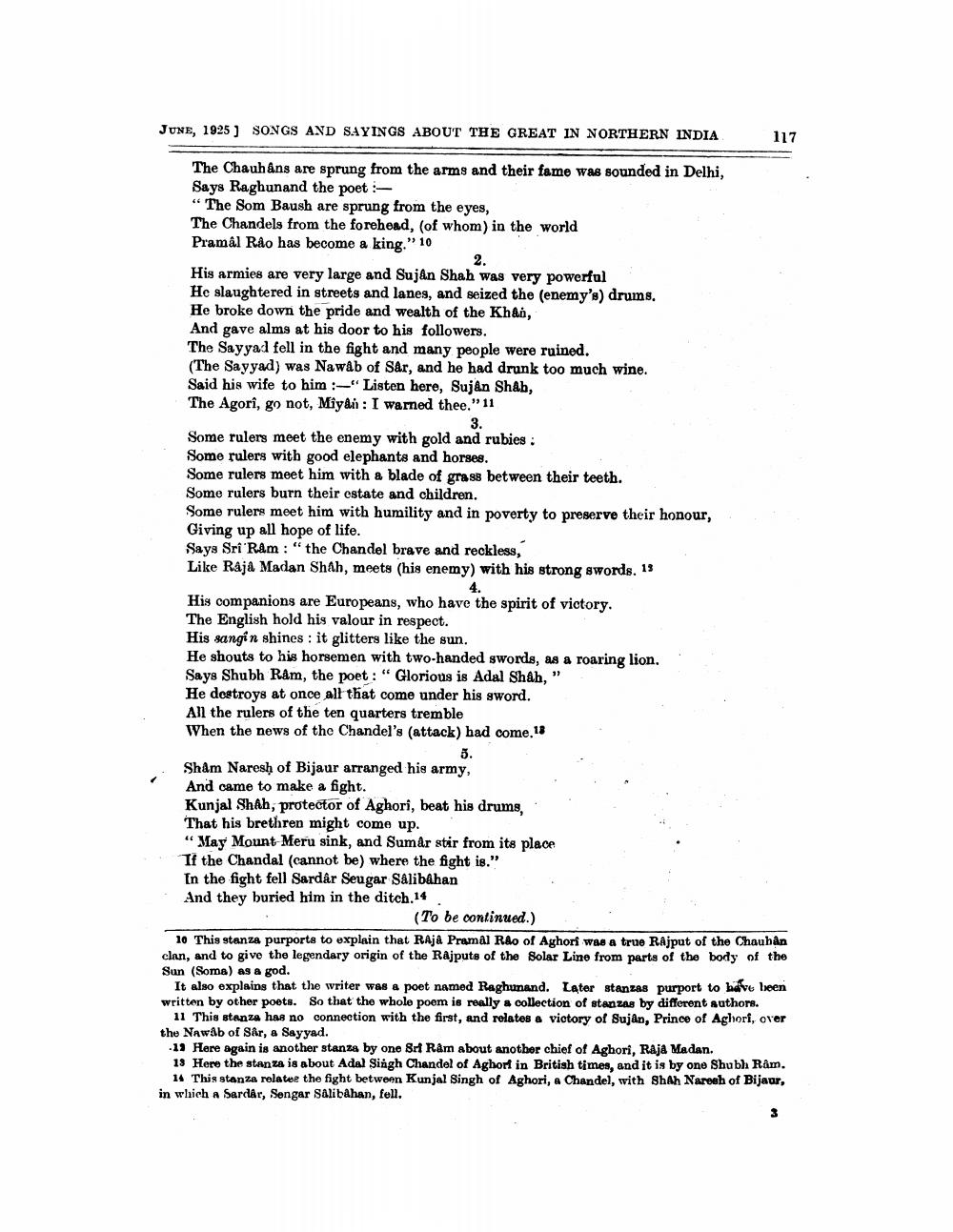________________
JUNE, 1925] SONGS AND SAYINGS ABOUT THE GREAT IN NORTHERN INDIA
The Chauhans are sprung from the arms and their fame was sounded in Delhi, Says Raghunand the poet :
"The Som Baush are sprung from the eyes,
The Chandels from the forehead, (of whom) in the world Pramâl Rao has become a king."
." 10
2.
His armies are very large and Sujan Shah was very powerful
He slaughtered in streets and lanes, and seized the (enemy's) drums.
He broke down the pride and wealth of the Khan,
And
gave alms at his door to his followers.
The Sayyad fell in the fight and many people were ruined.
(The Sayyad) was Nawab of Sår, and he had drunk too much wine. Said his wife to him :-"Listen here, Sujan Shah, The Agorî, go not, Mîyan: I warned thee."11
3.
Some rulers meet the enemy with gold and rubies:
Some rulers with good elephants and horses.
Some rulers meet him with a blade of grass between their teeth.
Some rulers burn their estate and children.
Some rulers meet him with humility and in poverty to preserve their honour, Giving up all hope of life.
Says Sri Ram: "the Chandel brave and reckless,
Like Raja Madan Shah, meets (his enemy) with his strong swords. 13
4.
His companions are Europeans, who have the spirit of victory.
The English hold his valour in respect.
His sangin shines: it glitters like the sun.
He shouts to his horsemen with two-handed swords, as a roaring lion. Says Shubh Râm, the poet: "Glorious is Adal Shah, "
He destroys at once all that come under his sword.
All the rulers of the ten quarters tremble
When the news of the Chandel's (attack) had come. 13
5.
Sham Naresh of Bijaur arranged his army,
And came to make a fight.
Kunjal Shah, protector of Aghori, beat his drums, That his brethren might come up.
"May Mount Meru sink, and Sumar stir from its place
If the Chandal (cannot be) where the fight is."
In the fight fell Sardar Seugar Sâlibâhan
And they buried him in the ditch.14
117
(To be continued.)
10 This stanza purports to explain that RAja Pramal Rao of Aghori was a true Rajput of the Chauhan clan, and to give the legendary origin of the Rajputs of the Solar Line from parts of the body of the Sun (Soma) as a god.
It also explains that the writer was a poet named Raghunand. Later stanzas purport to have been written by other poets. So that the whole poem is really a collection of stanzas by different authors. 11 This stanza has no connection with the first, and relates a victory of Sujan, Prince of Aghori, over the Nawab of Sâr, a Sayyad.
13 Here again is another stanza by one Sri Râm about another chief of Aghori, Raja Madan.
13 Here the stanza is about Adal Singh Chandel of Aghorf in British times, and it is by one Shubh Râm. 14 This stanza relates the fight between Kunjal Singh of Aghori, a Chandel, with Shah Naresh of Bijaur, in which a Sardar, Sengar Sâlibahan, fell.




